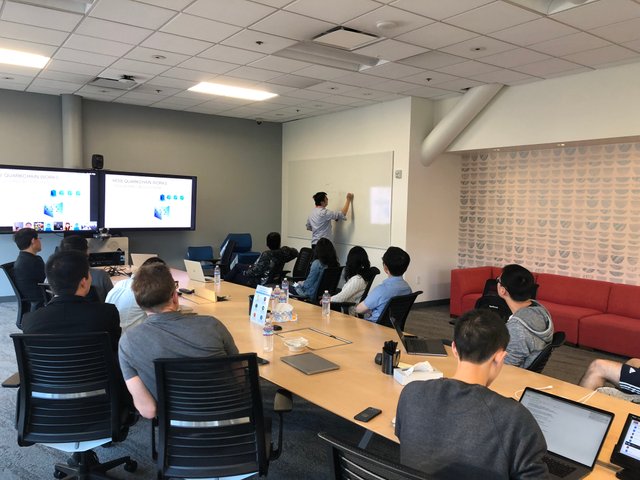Google ABC Q&A
On June 9, Qi Zhou, CEO and founder of QuarkChain talked to Google ABC team about blockchain technologies for 3 hours.
Google ABC, short for Google ABC Blockchain Community, is a group of Googlers who are interested in blockchain technologies. We meet up regularly to discuss about blockchain technology and projects. They are located on Building 43, 1600 Amphitheatre Pkwy, Mountain View, CA, 94043.

Here are the Q&As:
Q1: Suppose a shard runs PoW consensus with relatively weak hashpower. How could the system prevent the shard being attacked, e.g., double-spending attack?
A1: As long as a transaction is confirmed by root chain, then a double-spending attack must also attack the root chain by creating a longer root chain fork. Since the root chain has significantly hashpower of the network (50+%), attacking the root chain will be costly.
Q2: Is it possible that a transaction in a block is attacked by double spending before the block is included in root chain.
A2: For PoW, finality is subjective - a recipient (e.g., an exchange) decides how many block confirmations before a TX is finalized. In the case of QuarkChain, every transaction (block) is double-confirmed by both shard and root chain, and the recipient could either wait for only a few shard block confirmations or root block confirmations depending on the value of the transaction. Therefore, double spending attack is mitigated as long as a recipient relies on root-chain’s confirm.
However, the weak hashpower of a shard does open a window for blacklisting attack, where an attacker could blacklist a transaction in a shard (or perhaps all transactions from a user or all transactions in a shard) by always creating a longer fork. This means the attacker needs to always race with the main chain of the shard (as other miners could include the transactions again) with the risk that its fork could be discarded if the main chain of the shard is included in the root chain. Unlike double-spending attack, where an attacker could gain actual benefit from the attack, backlisting attack would block the transactions without long-term benefits, which should rarely occur as it does not follow economic man assumption.
Q3: Could you please compare your technologies with other competitors such as Zilliqa?
A3: Unlike most of the existing projects, our ideas are mainly inspired by a lot of centralized scalability technologies from Google and Facebook, which are mature and well proven in production for years. Our goal is to carefully select and integrate these technologies to be the first fit of blockchain. Compared to Zilliqa, there are a couple of major differences:
QuarkChain supports state sharding in clusters, while Zilliqa only supports network/transaction sharding, which means every node in Zilliqa needs to maintain full-ledger of the network.
QuarkChain supports turing-complete virtual machine (e.g., EVM) while Zilliqa’s smart contract is not turning-complete to our best knowledge
Q4: What kind of language is QuarkChain developed on?
A4: Current QuarkChain is developed on Python. We are C++/C programmers, but the main reason of choosing Python is its fast deployment so that we could focus more on our technology. Actually, we already obtain pretty decent performance results these days, and we could easily achieve much higher performance by employing other high-performance languages such as C++ and Go. Note that early Ethereum development also used Python, but later Go implementation becomes popular after Ethereum got more attention.
Q5: Would you please tell us more details about your testnet?
A5: We released an alpha version of our testnet in late March, and now we are working towards our beta testnet. The testnet will have most of the desired features including smart contract support via EVM, 128 shards, efficient cross-shard transactions, JSON-RPC APIs, etc. We currently have 100 volunteers that are helping us to test, and the early feedback is very positive. The testnet is expected to be public at the end of June or early July. We welcome any software engineers that are enthusiastic in blockchain technologies to join the program and help us improve our network.